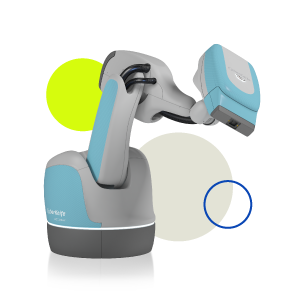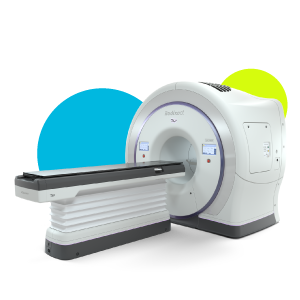At ASTRO 2022 over 1,600 abstracts were accepted, representing all aspects of oncology and radiation therapy for oncologic and non-oncologic conditions. The extensive breadth and depth of abstracts underscores the importance clinicians worldwide place on radiation therapy related research.
With a focus on CyberKnife® and TomoTherapy®/Radixact® Treatment Delivery Systems, we have highlighted some abstracts utilizing real-time target tracking with dynamic delivery, ClearRTTM helical fan-beam kVCT imaging, and the superior dosimetric properties of helical TomoTherapy. Below are summaries of several abstracts in the treatment of prostate and breast cancer, oligometastases, brain metastases, and the accuracy of ClearRT as a key tool in adaptive radiotherapy.
Prostate Cancer
The correlation of adipose tissue and treatment failure in SBRT1
Obese prostate cancer patients undergoing external beam radiation therapy may experience worse outcomes than patients with normal body weight because excess pelvic adipose tissue can make precise delivery of radiation challenging. A study analyzed 1306 patients treated with the CyberKnife System with a median body mass index (BMI) of 27.6 kg/m2. At a median follow-up of 47 months, results indicated that BMI did not lead to worse outcomes in this cohort of patients after stereotactic body radiation therapy (SBRT). They conclude that obesity should not be a contraindication to prostate SBRT.
Motion compensation devices are a necessity to deliver SBRT to the prostate safely2
Hypofractionated radiation therapy is becoming increasingly common in the treatment of prostate cancer. High doses delivered in fewer fractions require extreme precision, especially in anatomical regions subject to internal fluctuations. A study reported dose delivery accuracy using real-time motion tracking and dynamic delivery using the Radixact System in prostate SBRT. Fourteen patients with a prescription of 40 Gy in 5 fractions were reviewed. For most OARs, delivered Dmax was within 2% of the planned dose. Of the 12 patients with 1-month follow-up, only 3 patients reported grade 1 GU toxicity and 2 patients reported grade 1 GI toxicity. The study concluded that the range of motions detected within the treatment area highlights the need for motion compensation techniques for precise treatment delivery in prostate cancer patients.
Breast Cancer
Stereotactic partial breast irradiation (S-PBI) using the CyberKnife System is a less invasive modality3
In early-stage breast cancer, partial breast irradiation allows a reduction of dose to the normal tissues confining the radiation target. A prospective study evaluated the early toxicity and cosmetic outcomes in breast cancer patients undergoing 30 Gy in 5 fractions S-PBI using the CyberKnife System. Two hundred and four patients were included in a 2-year follow-up. The study found that patients undergoing S-PBI presented significantly less fibrosis at 6 months than those who underwent whole breast irradiation. Cosmetic outcomes were excellent to good at 2 years in 82% of patients with minimal toxicity.
Efficacy of SBRT in high-volume metastatic breast carcinoma4
The treatment of metastatic breast cancer is challenging and has largely focused on systemic therapy. However, in recent years there is a growing interest in the use of metastasis-directed radiation therapy in oligometastatic cases. A prospective study evaluated the efficacy and feasibility of SBRT in high-volume metastatic breast cancer. SBRT was delivered using CyberKnife with real-time tracking to the brain, liver, lung, bone, and adrenal glands. Doses of 25-30 Gy were delivered in 3-5 fractions. A total of 47 patients were included with a total of 103 metastatic sites treated. Overall survival at 1-year was 78.4%. The study concluded that SBRT is a feasible option in metastatic breast cancer patients with high local control and overall survival.
Brain Metastases
Helical TomoTherapy shows favorable dosimetric properties5
Stereotactic radiosurgery (SRS) is an effective treatment in patients with multiple brain metastases. A single institutional phase II study investigated the feasibility of hypofractionated SRS with or without simultaneous whole-brain radiotherapy using helical TomoTherapy in patients with multiple brain metastases. Doses were optimized based on tumor volume and location. The number of brain lesions ranged from 3-43 with a median volume of 18.3 cc. The 1-year local control was 96.4% and the intracranial progression-free survival was 80.5%. Of the 69 patients, 23 were recontoured during their course of treatment due to a volume decrease. The study concluded that helical TomoTherapy was well tolerated and could significantly extend intracranial progression-free survival.
ClearRT Helical Fan-beam kVCT
Impact of CT number calibration and imaging parameters on adaptive dose calculation accuracy6
ClearRT helical kVCT imaging provides clinicians with high-fidelity images for use in radiation therapy treatment delivery and planning. Accuracy of dose calculations is a necessary step toward the implementation of adaptive planning in clinics. A study evaluated the CT number calibration and imaging parameters for ClearRT on the Radixact System.
Study investigators reviewed fine, normal, and coarse modes using an anthropomorphic phantom. The study found that the use of fine mode for helical kVCT number calibration and image acquisition resulted in dose calculations most consistent with those calculated on diagnostic-quality CT images. They noted using fine mode is associated with an increase in imaging dose and where this is a concern, normal and coarse modes could also be used with a reasonable dose calculation tolerance. An interesting finding was that while fine mode increases scan times relative to other modes, this additional time is still significantly less to on-board CBCT or MVCT systems currently used for CT-based online adaptive planning.
Reference:
- Conroy, D et al (2022) ‘Correlation between Obesity and Treatment Failure Following Stereotactic Body Radiation Therapy (SBRT) for Clinically Localized Prostate Cancer’ International Journal of Radiation Oncology, Biology, Physics. Abstract: 2486. Vol. 114Issue 3Supplemente217
- Goddard, L. et al (2022) ‘Real-World Dose Delivery Accuracy of Prostate SBRT with TomoTherapy Based Target Tracking’ International Journal of Radiation Oncology, Biology, Physics. Abstract:3195. Volume 114, Issue 3, e534
- Byun, H.K. et al (2022) ‘Evaluation of Early Cosmetic Outcome and Toxicity after 5-Fraction Stereotactic Partial Breast Irradiation in Early-Stage Breast Cancer: A Prospective Cohort Study’ International Journal of Radiation Oncology, Biology, Physics. Abstract: 2031. Volume 114, Issue 3, e15
- Sridhar, P et al (2022) ‘Efficacy of SBRT in High Volume Metastatic Carcinoma Breast – A Berry Picking Approach in the Era of High Precision Radiotherapy’ International Journal of Radiation Oncology, Biology, Physics. Abstract: 2026. Volume 114, Issue 3, e12 – e13
- Ma, Y. et al (2022) ‘Hypofractionated Stereotactic Radiotherapy with or without Whole Brain Radiotherapy with Helical TomoTherapy for Multiple Brain Metastases – Long-Term Follow-Up Results of a Phase II Trial’ International Journal of Radiation Oncology, Biology, Physics. Abstract: 2129. Volume 114, Issue 3, e58 – e59
- Tegtmeier, R.C. et al (2022) ‘Considerations for CT Number Calibration and Imaging Parameter Selection for Adaptive Planning on a Novel On-Board Helical kVCT System’ International Journal of Radiation Oncology, Biology, Physics. Abstract: 3346. Volume 114, Issue 3, e599









